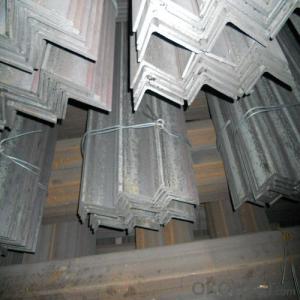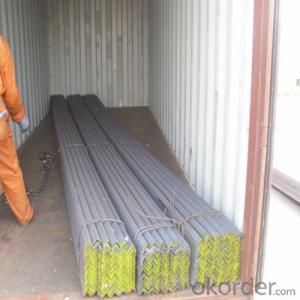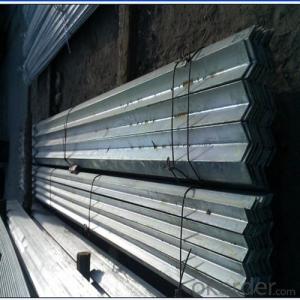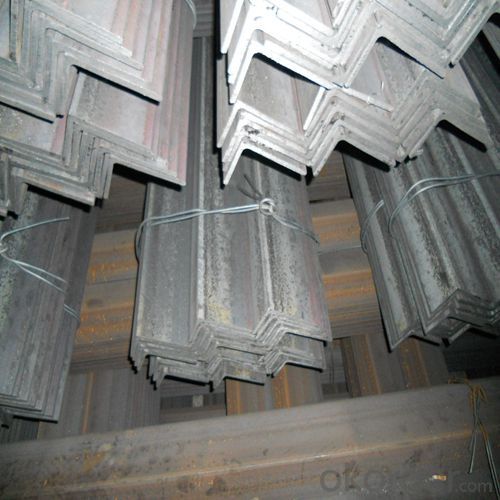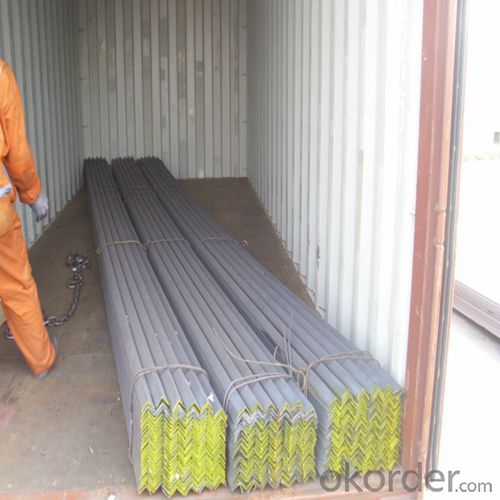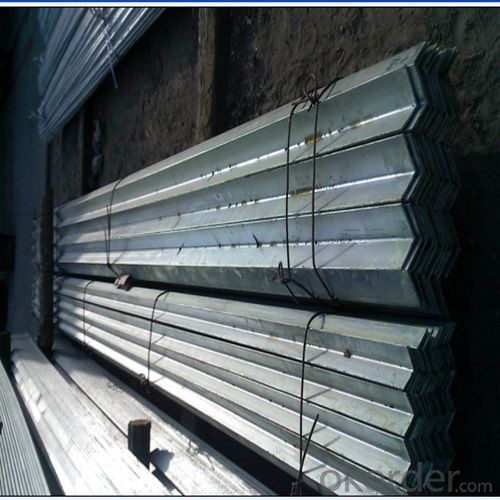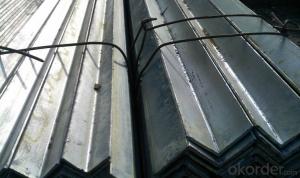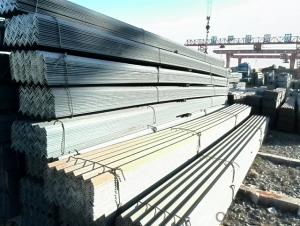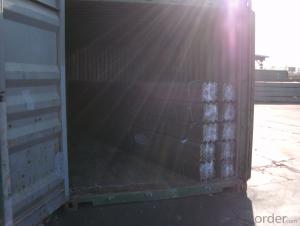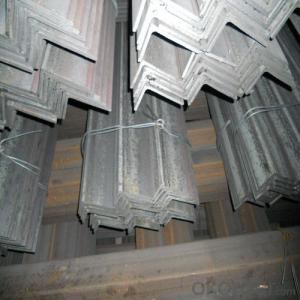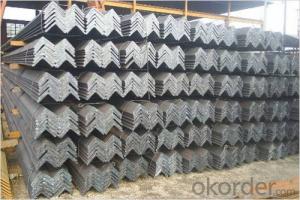Hot Rolled Steel Angle Euqal Angle Bar Uneuqal Angle Bar Q235
- Loading Port:
- Tianjin
- Payment Terms:
- TT or LC
- Min Order Qty:
- 50 m.t.
- Supply Capability:
- 50000 m.t./month
OKorder Service Pledge
OKorder Financial Service
You Might Also Like
Product Description:
OKorder is offering high quality Hot Rolled Steel I-Beams at great prices with worldwide shipping. Our supplier is a world-class manufacturer of steel, with our products utilized the world over. OKorder annually supplies products to European, North American and Asian markets. We provide quotations within 24 hours of receiving an inquiry and guarantee competitive prices.
Product Applications:
Hot Rolled Steel I-Beams are ideal for structural applications and are widely used in the construction of buildings and bridges, and the manufacturing, petrochemical, and transportation industries.
Product Advantages:
OKorder's Steel I-Beams are durable, strong, and resist corrosion.
Main Product Features:
· Premium quality
· Prompt delivery & seaworthy packing (30 days after receiving deposit)
· Corrosion resistance
· Can be recycled and reused
· Mill test certification
· Professional Service
· Competitive pricing
Product Specifications:
1.Grade: SS200,300,400 series
2.Size: 25×25×3 mm-100×100×10mm
3.Process: HRAP
4. Length: 2-6m
5. Shape: Equal
6. Delivery: within 20 days
7. MOQ: 1 ton
8. Certificate: ISO 9001:2008, SGS
9. Package:Standard Export Packing, or put into wooden boxes according to your requirement
10. Application: Construction, Marine, Industry and so on
Name | Stainless Steel Angles | ||||||
Standard | ASTM A554, A312, A249, A269 and A270 | ||||||
Material Grade | 304,316,201,202, 316L,430 | ||||||
Length | 6m or as customers' request | ||||||
Tolerance | a) thickness: +/-0. 15mm | ||||||
b) Length:+/-4. 5mm - 0mm | |||||||
Surface | 180G, 320G, 400G Satin / Hairline(Matt Finish, Brush, Dull Finish) 400G, 500G, 600G or 800G Mirror finish | ||||||
Application | Decoration construction, upholstery, industry instruments | ||||||
Test | Squash test, Extended test, Water pressure test, Crystal rot test, Heat treatment, NDT | ||||||
Chemical Composition of Material |
Composition
Material | 201 | 202 | 304 | 316L | 430 | |
C | ≤0.15 | ≤0.15 | ≤0.08 | ≤0.08 | ≤0.12 | ||
Si | ≤1.00 | ≤1.00 | ≤1.00 | ≤1.00 | ≤1.00 | ||
Mn | 5.5-7.5 | 7.5-10 | ≤2.00 | ≤2.00 | ≤1.00 | ||
P | ≤0.06 | ≤0.06 | ≤0.045 | ≤0.045 | ≤0.040 | ||
S | ≤0.03 | ≤0.03 | ≤0.030 | ≤0.030 | ≤0.030 | ||
Cr | 16-18 | 17-19 | 18-20 | 16-18 | 16-18 | ||
Ni | 3.5-5.5 | 4-6 | 8-10.5 | 10-14 | |||
Mo | 2.0-3.0 | ||||||
Mechanical Property | Material Item | 201 | 202 | 304 | 316L | ||
Tensile Strength | ≥535 | ≥520 | ≥520 | ≥520 | |||
Yield Strength | ≥245 | ≥205 | ≥205 | ≥205 | |||
Extension | ≥30% | ≥30% | ≥35% | ≥35% | |||
Hardness (HV) | <253 | <253 | <200 | <200 | |||
FAQ:
Q1: Why buy Materials & Equipment from OKorder.com?
A1: All products offered byOKorder.com are carefully selected from China's most reliable manufacturing enterprises. Through its ISO certifications, OKorder.com adheres to the highest standards and a commitment to supply chain safety and customer satisfaction.
Q2: How do we guarantee the quality of our products?
A2: We have established an advanced quality management system which conducts strict quality tests at every step, from raw materials to the final product. At the same time, we provide extensive follow-up service assurances as required.
Q3: How soon can we receive the product after purchase?
A3: Within three days of placing an order, we will begin production. The specific shipping date is dependent upon international and government factors, but is typically 7 to 10 workdays.
Q4: What makes stainless steel stainless?
A4: Stainless steel must contain at least 10.5 % chromium. It is this element that reacts with the oxygen in the air to form a complex chrome-oxide surface layer that is invisible but strong enough to prevent further oxygen from "staining" (rusting) the surface. Higher levels of chromium and the addition of other alloying elements such as nickel and molybdenum enhance this surface layer and improve the corrosion resistance of the stainless material.
Q5: Can stainless steel rust?
A5: Stainless does not "rust" as you think of regular steel rusting with a red oxide on the surface that flakes off. If you see red rust it is probably due to some iron particles that have contaminated the surface of the stainless steel and it is these iron particles that are rusting. Look at the source of the rusting and see if you can remove it from the surface.
Images:
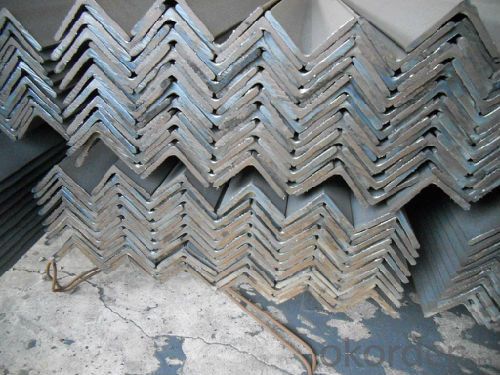
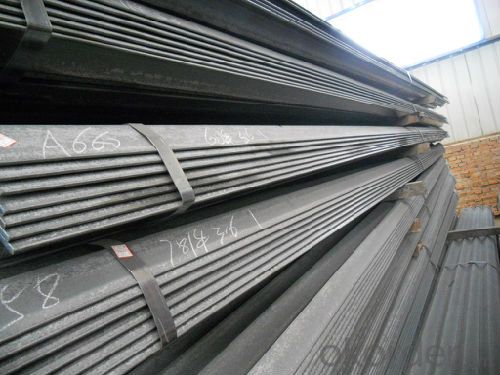
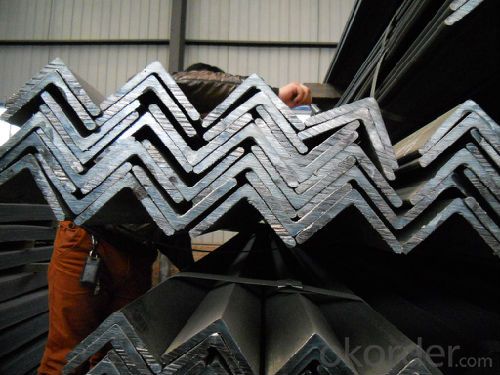
- Q: Can steel angles be used in sign support structures?
- Absolutely! Sign support structures can definitely utilize steel angles. These angles are widely employed in construction owing to their remarkable robustness and endurance. They offer exceptional support and stability, rendering them ideal for various applications, including sign support structures. By welding or bolting steel angles together, a strong framework can be effortlessly created for sign mounting. Furthermore, their exceptional load-bearing capacity is crucial in guaranteeing the sign's security and stability, particularly during unfavorable weather conditions. Moreover, steel angles can be tailored to meet specific design specifications, making them a versatile option for sign support structures.
- Q: How do steel angles perform in high-vibration environments?
- Steel angles are well-suited for high-vibration environments due to their excellent structural strength and stability. The inherent properties of steel, such as its high tensile strength and rigidity, allow steel angles to withstand dynamic loads and vibrations without compromising their structural integrity. Steel angles are commonly used in applications such as machinery, construction, and transportation, where vibrations are prevalent. The design of steel angles, with their L-shaped cross-section, also contributes to their performance in high-vibration environments. The right angle shape provides additional support and resistance against bending and torsional forces, making steel angles more resistant to vibrations compared to other materials. This design feature helps to minimize any potential deformation or fatigue that could occur under constant vibrational stress. Moreover, steel angles can be further enhanced to withstand high-vibration environments through surface treatments and coatings. Techniques such as galvanization or painting can provide a protective layer that adds corrosion resistance and prevents degradation of the steel's mechanical properties. This added protection ensures the longevity and durability of steel angles in challenging environments. In summary, steel angles are an ideal choice for high-vibration environments due to their robust nature, L-shaped design, and potential for surface treatments. Their ability to withstand dynamic loads, resist bending and torsional forces, and maintain structural integrity make them reliable and efficient components in various industries where vibration is a concern.
- Q: Can steel angles be used as supports for suspended acoustical ceilings?
- Yes, steel angles can be used as supports for suspended acoustical ceilings. Steel angles are commonly used in construction for providing structural support and stability. They can be attached to the walls or ceiling to create a framework for suspending acoustical ceiling panels. The angles provide a stable base for the ceiling system and help distribute the weight evenly, ensuring the longevity and durability of the suspended acoustical ceilings.
- Q: How do you determine the strength of a steel angle?
- The strength of a steel angle depends on various factors, such as its material composition, size, and shape. In terms of material composition, the type of steel used greatly affects its strength. Steel angles are commonly made from alloys like carbon steel or stainless steel, each with their own unique strength properties. The grade or type of steel employed directly impacts the angle's strength, with higher-grade steels generally exhibiting greater strength. The size of the steel angle is also a significant factor in determining its strength. The angle's dimensions, including its length, width, and thickness, directly influence its load-bearing capacity. Generally, larger and thicker steel angles are capable of withstanding higher loads and forces. Furthermore, the shape of the steel angle plays a role in its strength. Typically, steel angles are available in L-shapes, where the legs are perpendicular to one another. The length and angle of the legs can impact the angle's strength. For instance, longer legs or a steeper leg angle can increase the strength and load-bearing capacity of the steel angle. To accurately determine the strength of a steel angle, engineers typically perform calculations and analysis. These calculations involve considering the material properties, dimensions, and loading conditions to ascertain the maximum load or stress the angle can withstand without failure. Additionally, industry standards and codes, such as those established by organizations like ASTM or AISC, provide guidelines and specifications for assessing the strength of steel angles.
- Q: What are the common applications of steel angles in the automotive industry?
- The automotive industry frequently relies on steel angles for a variety of purposes due to their versatility and strength. One specific use in this industry involves the construction of vehicle frames and chassis, where steel angles are commonly employed to ensure structural support and rigidity. This, in turn, guarantees the overall strength and stability of the vehicle. Another common application for steel angles is in the production of brackets and mounting components. These angles are utilized to securely attach various parts - such as engine mounts, suspension components, and exhaust systems - to the chassis of the vehicle. By doing so, steel angles contribute to the proper functioning and longevity of these components. Steel angles are also heavily involved in the creation of safety features within automobiles. For example, they are crucial in the construction of roll cages, which safeguard occupants in the event of a rollover or collision. Due to their exceptional strength and ability to absorb and distribute impact forces, steel angles are preferred for roll cages, ultimately enhancing the safety of the vehicle. Furthermore, steel angles have a wide range of applications in the design and production of various automotive accessories and components. They are commonly utilized as reinforcement in door panels, fenders, and bumpers, elevating the overall structural integrity of these parts. Additionally, steel angles are employed in the fabrication of trailer hitches, tow bars, and roof racks, providing robust and secure attachment points for towing and carrying heavy loads. To summarize, steel angles play a critical role in the automotive industry by offering structural support, facilitating secure connections, enhancing safety, and improving the overall performance and durability of vehicles and their components.
- Q: Can steel angles be used in the construction of museums?
- Museums can utilize steel angles in their construction. These angles are widely employed in the construction industry due to their strength and versatility. They play a critical role in providing structural support and stability to buildings, making them suitable for various applications, including museums. When constructing museums, steel angles can be utilized in multiple ways. They can serve as framing components for walls, ceilings, and floors, ensuring a robust and long-lasting structure. Additionally, steel angles can function as support brackets for shelves, display cases, and mounting systems for artwork or exhibits. Furthermore, steel angles are ideal for constructing staircases, ramps, and walkways within museums, guaranteeing safe and secure access for visitors. They can also be employed in fabricating structural elements like beams, columns, and trusses, thereby enhancing the overall stability and load-bearing capacity of the museum. Moreover, steel angles offer design flexibility, enabling architects and engineers to create intricate and aesthetically pleasing structures within museums. They can be easily customized and fabricated into various shapes and sizes to meet specific design requirements. Overall, steel angles are a dependable and efficient choice for museum construction. They possess the necessary strength, stability, and design versatility required to create functional and visually appealing spaces to showcase art, artifacts, and exhibits.
- Q: Can steel angles be used for green building projects?
- Yes, steel angles can be used for green building projects. Steel is a highly sustainable and eco-friendly material due to its durability, recyclability, and energy efficiency. Steel angles, also known as L-shaped steel, are commonly used in construction for their strength and versatility. They can be utilized in various ways in green building projects, such as framing, structural support, and reinforcement. Steel angles are often made from recycled steel, reducing the need for extracting new raw materials and minimizing waste. Additionally, steel can be recycled indefinitely without losing its strength or quality, making it a highly sustainable option. The use of recycled steel angles in green building projects helps to reduce carbon emissions and conserve natural resources. Furthermore, steel is an energy-efficient material that can contribute to the overall energy efficiency of a building. Steel angles can be used in the construction of energy-efficient systems like solar panel mounting structures, wind turbine towers, and other renewable energy infrastructure. Steel's strength and durability also allow for the design of lightweight structures, reducing the overall energy required for construction and transportation. Steel angles are also resistant to pests, fire, and moisture, ensuring the longevity and durability of green buildings. Their versatility allows for easy integration with other sustainable building materials, such as recycled concrete, wood, and glass, further enhancing the environmental performance of the project. In conclusion, steel angles can definitely be used for green building projects. Their sustainability, durability, recyclability, and energy efficiency make them an ideal choice for constructing environmentally friendly and sustainable buildings.
- Q: How are steel angles supported during installation?
- Steel angles are typically supported during installation by using various techniques and materials. One common method is to use steel brackets or supports that are designed to hold the angles in place. These brackets are often attached to the structure using bolts or screws and provide stability and structural integrity to the angles. Another method of support is to weld the steel angles directly to the structure. This involves using a welding process to fuse the angles to the existing steel framework, ensuring a strong and secure connection. Welding is often preferred in situations where the angles need to bear heavy loads or where additional strength is required. In some cases, steel angles may also be supported using concrete or masonry. This involves embedding the angles into the concrete or masonry structure, providing a solid and stable foundation for the installation. This method is commonly used in construction projects where the angles need to be securely fixed to the building or where additional reinforcement is required. Overall, the specific method of supporting steel angles during installation will depend on the requirements of the project, the load-bearing capacity needed, and the design specifications. It is important to follow the appropriate industry standards and guidelines to ensure a safe and successful installation.
- Q: Can steel angles be used for staircases?
- Certainly! Steel angles are indeed suitable for the construction of staircases. Their strength and durability make them a popular choice in the field of construction. In terms of staircases, steel angles are frequently employed as stringers or support beams to ensure structural stability. They play a crucial role in establishing the framework or skeleton of the staircase, supporting the steps and providing a secure footing for individuals. Steel angles possess a high level of versatility and can be readily tailored and fabricated to meet the precise design specifications of staircases. Furthermore, their resistance to corrosion renders them suitable for both indoor and outdoor staircases.
- Q: What is the minimum bend radius for a steel angle?
- The minimum bend radius for a steel angle depends on the specific dimensions and thickness of the angle. It is generally recommended to consult the manufacturer or reference industry standards to determine the appropriate minimum bend radius for a particular steel angle.
Send your message to us
Hot Rolled Steel Angle Euqal Angle Bar Uneuqal Angle Bar Q235
- Loading Port:
- Tianjin
- Payment Terms:
- TT or LC
- Min Order Qty:
- 50 m.t.
- Supply Capability:
- 50000 m.t./month
OKorder Service Pledge
OKorder Financial Service
Similar products
Hot products
Hot Searches
Related keywords
